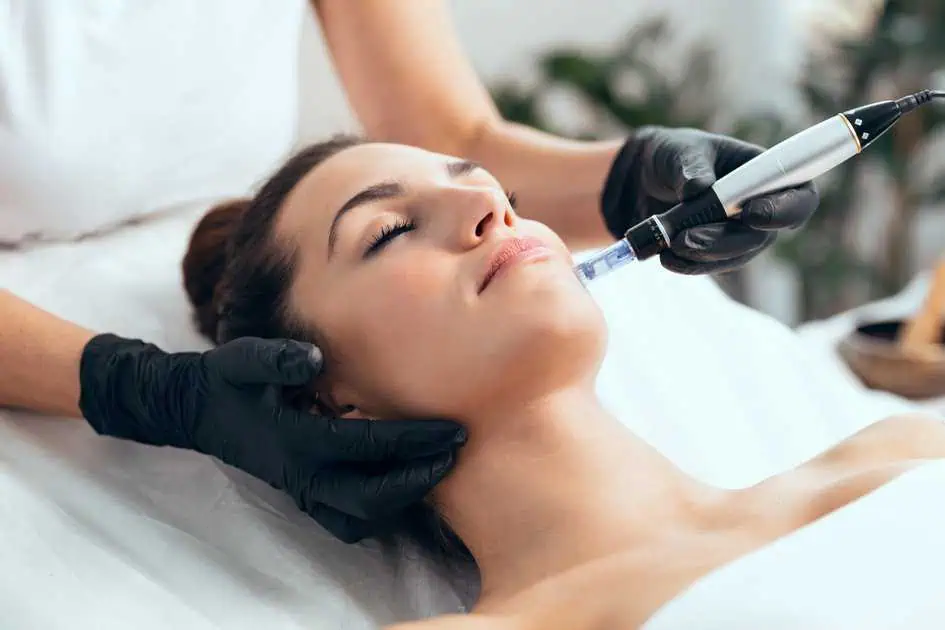At Fyre Aesthetics, we understand the profound impact that acne scars can have on one’s self-esteem and confidence. These scars, often a reminder of past acne battles, can be frustrating. Fortunately, various treatments are available to address acne scars, and one such option gaining popularity is microneedling.
In this comprehensive guide, we will explore the world of microneedling and how it can help fade those pesky acne scars. By the end, you’ll better understand whether microneedling is the right solution for you.
Understanding Acne Scars
Before we dive into microneedling, it’s essential to understand the nature of acne scars. Acne scars come in various forms, including icepick, rolling, and boxcar scars, each with unique characteristics. These scars occur when the skin’s tissue is damaged during the healing process of acne lesions.
The causes of acne scars are multifaceted. Factors like inflammation, genetics, and the severity of acne can contribute to scar formation. Because acne scars often involve both the epidermis and dermis layers of the skin, they can be particularly challenging to treat effectively.
What is Microneedling?
Microneedling, also known as collagen induction therapy, is a minimally invasive cosmetic procedure designed to improve the skin’s texture and appearance. It involves the use of a device equipped with fine, sterile needles that create tiny punctures or micro-injuries on the skin’s surface.
The micro-injuries triggered by microneedling stimulate the body’s natural wound-healing process. This, in turn, promotes collagen and elastin production, two essential proteins that help maintain the skin’s youthful and smooth appearance.
Microneedling for Acne Scars
Let’s get to the heart of the matter: can microneedling help fade acne scars? The answer is a resounding yes! Microneedling is a promising solution for individuals dealing with acne scars for several reasons:
Collagen Production: One of the primary mechanisms behind microneedling’s effectiveness is its ability to boost collagen production. Collagen is a structural protein that provides strength and elasticity to the skin. By stimulating collagen production, microneedling helps rebuild and repair the damaged skin tissue associated with acne scars.
Improved Skin Texture: The skin’s texture improves as collagen production increases. Over time, microneedling can help smooth out the uneven surfaces caused by acne scars, making the skin appear more even-toned and youthful.
Minimal Downtime: Compared to more invasive treatments, microneedling offers minimal downtime. After a session, you may experience some redness and minor swelling, but these side effects typically subside within a few days. This makes microneedling an attractive option for those with busy lifestyles.
Versatility: Microneedling can be customized to target specific areas of concern. Whether you have isolated acne scars or more widespread scarring, microneedling can be tailored to meet your unique needs.
The Microneedling Process
Now that you understand why microneedling is effective, let’s delve into what the microneedling process entails:
Step 1: Consultation
The journey begins with a consultation with a qualified practitioner at Fyre Aesthetics. During this meeting, your provider will assess your skin, discuss your goals, and determine if microneedling is the right treatment for you.
Step 2: Preparation
Before the procedure, your skin will be thoroughly cleansed, and a numbing cream may be applied to ensure your comfort during the treatment.
Step 3: Microneedling
The microneedling device is gently applied to the skin’s surface, creating controlled micro-injuries. These tiny punctures stimulate collagen and elastin production, kickstarting the skin’s natural healing process.
Step 4: Aftercare
After the procedure, your skin may appear slightly red and swollen. Your practitioner will provide specific post-treatment care instructions to ensure a smooth recovery.
Results and Expectations
While microneedling can produce remarkable results, setting realistic expectations is essential. The process is gradual and may take several sessions to achieve your desired outcome. Patience is key when it comes to microneedling for acne scars.
As collagen production continues in the weeks and months following your microneedling sessions, you’ll notice a gradual improvement in your skin’s texture and a reduction in the appearance of acne scars. For some individuals, dramatic changes may be seen after just a few sessions, while others may require more treatments for optimal results.
Who Is a Suitable Candidate?
Microneedling is generally suitable for a wide range of individuals. However, it may not be recommended for everyone. Your practitioner will help determine if you are a suitable candidate during your consultation.
In general, microneedling can benefit those with:
- Mild to moderate acne scars
- Uneven skin texture
- Fine lines and wrinkles
- Enlarged pores
- Stretch marks
Microneedling vs. Other Acne Scar Treatments
It’s natural to wonder how microneedling compares to other common treatments for acne scars. Here’s a brief comparison:
Microneedling vs. Chemical Peels
- Microneedling stimulates collagen production, while chemical peels exfoliate the skin’s surface.
- Chemical peels may require more downtime and have a higher risk of complications.
Microneedling vs. Laser Therapy
- Both microneedling and laser therapy can be effective for acne scars, but microneedling is generally associated with less downtime and a lower risk of side effects.
- The choice between the two often depends on the type and severity of acne scars.
Risks and Side Effects
While microneedling is considered safe, being aware of potential risks and side effects is essential. These may include:
- Redness and swelling (usually temporary)
- Mild discomfort during the procedure
- Skin sensitivity
- Rarely, infection or scarring (if proper aftercare is not followed)
To minimize the risk of complications, choosing a qualified and experienced practitioner like those at Fyre Aesthetics is crucial.
Frequently Asked Questions
- Is microneedling painful? Microneedling is generally well-tolerated. The application of a numbing cream before the procedure helps minimize discomfort.
- How many sessions are needed? The number of sessions required varies depending on the severity of your acne scars. Your practitioner will create a customized treatment plan for you.
- When will I see the results? You may notice skin texture improvements after the first session, but significant results typically become more apparent after several sessions.
Conclusion
Microneedling is a promising option for individuals seeking to fade acne scars and improve their skin’s overall texture. At Fyre Aesthetics, we are committed to helping you achieve the clear, smooth skin you desire.
If you’re ready to take the next step toward a scar-free complexion, don’t hesitate to contact our experienced team for a consultation. We’re here to guide you to radiant, blemish-free skin.
Contact Fyre Aesthetics today to schedule your consultation and discover how microneedling can help you achieve your skincare goals. Share this informative post with friends and family who may benefit from this transformative treatment.




